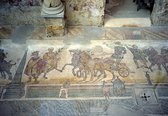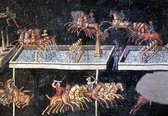The name & the logo
 The idea
The idea behind the company
 History
Historyof the company
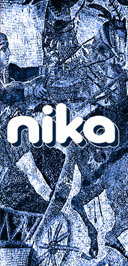 The name & the logo
The name & the logo
 Important Persons
Important Persons
 Remedia Veterinaria
Remedia VeterinariaGroup
The name of the company comes from the Greek word Nika (Νίκα), whose interesting history is over 2000 years old. In literary translation, the word “nika” means “to win” or “to go forward”. It reflects the continuous drive to learn and develop in the company’s domain, namely issues concerning natural immunity and the fight against infections, as well as issues connected with natural lysozyme and its polymers.
The term “nika” shares a common origin with the Greek goddess Nike (Νίκη), who represents victory and has often been portrayed as a youthful winged woman bearing an olive branch in her hand. In the Roman Empire spectators shouted “Nika” to encourage competitors to battle hard in various sports competitions, especially in the chariot races.

Silver Greek coins: on the left a teradrachma from the time of the tyrant Hieron I (Syracuse, Sicily, ca 470-466 BC). The obverse depicts the goddess Nike flying over a quadriga (chariot drawn by four steeds).
On the right: a drachma form the time of the Roman Republic, (ca 111- 110 BC) with a magnificent dynamic picture of a galloping quadriga driven by the goddess Nike.
Ancient societies organized themselves into so called circus movements, which resembled political parties and referred, in their names, to the four seasons of the year. These fractions formed pairs, which coexisted in mutual “antagonism”. For example, Whites (Lenkoi) refers to the white and chill of winter snow versus the Reds (Rousioi), who had Sirius as their sign (in Greek: hot, flammable), i.e. the brightest star in the constellation of the Great Dog, linked to the summer solstice. There were also the Blues (Venetoi), who were associated with the autumn winds and water, i.e. all those who benefited from the sea, such as sailors, merchants, fishermen, port and navy personnel, against the Greens (Prasinoi), who were associated with the earth and spring (farmers, drivers, builders of roads and houses, and soldiers). Alliances were established in pairs based on similarities: Whites-Blues and Reds-Greens. All wore fancy clothes, often in colors that were characteristic of their factions. In time, the factions lost their sportsconnection and became primarily political parties. In the time of the Emperor Justinian (sixth century BC), only the Blues (aristocracy and rich citizens) and the Greens (small craftsmen, peasants and the poor) had any significance. Hence, the ruler was the supporter of the first group.
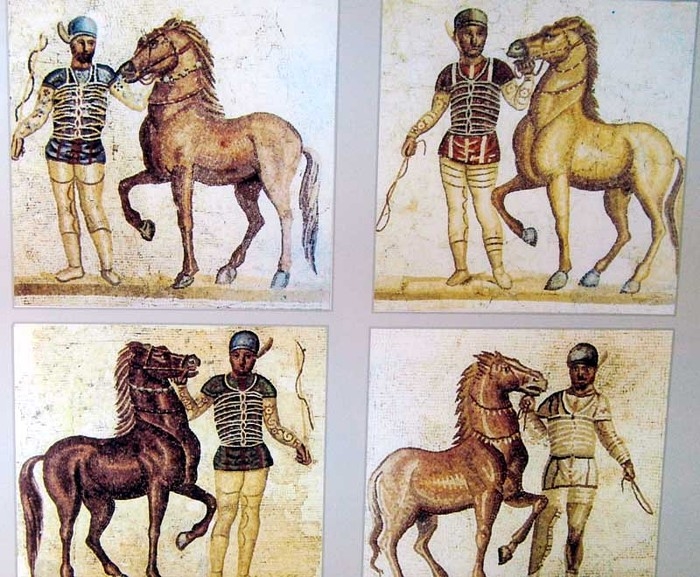
Drivers (Latin: auriga) wearing clothes characteristic of the four factions.
The most important role of a faction was to organize various sports competitions, mainly racechariot races at hippodromes throughout the empire. The factions employed not only professional drivers and their assistants, but also artists who glorified the achievements of their sporting champions and ran “publicity campaigns” for their factions. The factions also had numerous dedicated followers, who manifested their beliefs by wearing the appropriate colour of clothing and who, on the day of the races, sat in designated sectors of the hippodrome to support their teams. The factions often consisted of a mixture of street gangs and party members who took stands on all important issues and disrupted public arguments, including between candidates for the throne.
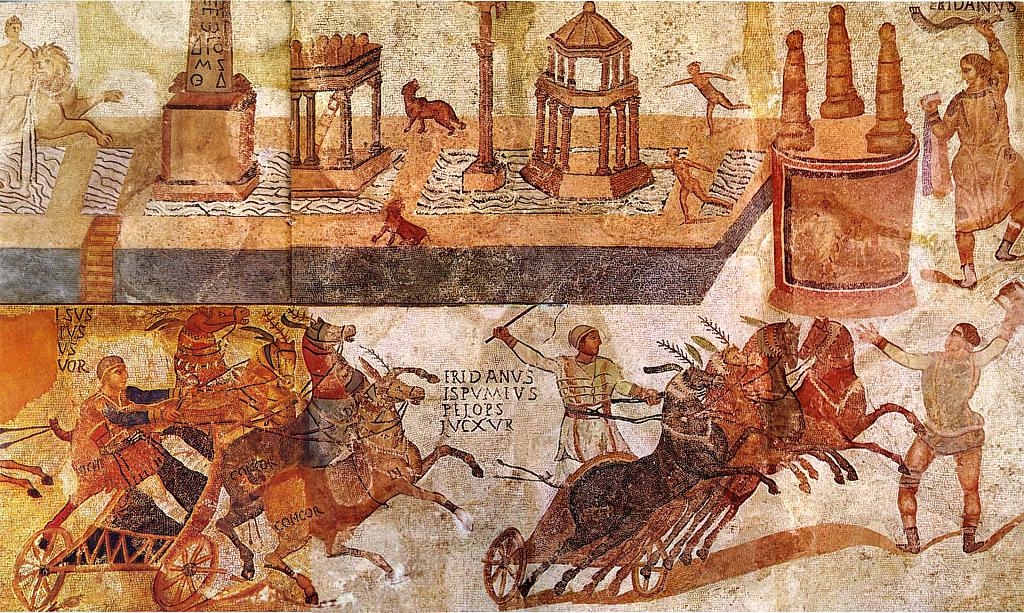
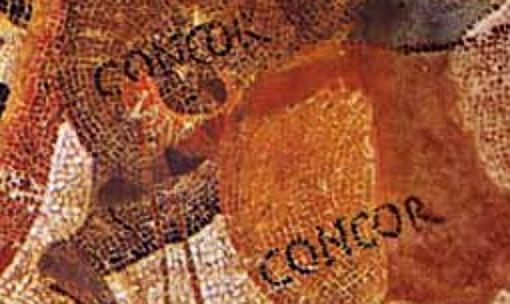
A chariot race at a hippodrome. The reconstruction of a mosaic from the ancient palace Reial Menor in Barcelona (IV century BC). The word “concor” is the Latin counterpart of the word “nika”.
The Catan Archeological Museum in Barcelona.
28 BC, Virgil, the author of “The Aeneid”, described in his poem “The Georgics” the extraordinary emotions evoked during a race at the Roman hippodrome.
See you not, when in headlong contest
the chariots have seized upon the plain, and stream in a torrent from the barrier,
when the young driver's hopes are high, and throbbing
fear drains each bounding heart? On they press with circling lash,
bending forward to slacken rein; fiercely flies the glowing wheel.
Now sinking low, now raised aloft,
they seem to be borne through empty air and to soar skyward.
No rest, no stay is there; but a cloud of yellow sand mounts aloft,
and they are wet with the foam and the breath of those in pursuit:
so strong is their love of renown, so dear in triumph.
(Georgiki, III, 103-112).
500 years later Sidonius Apollinaris, a Roman poet, diplomat and bishop, described the exciting course of a race in a poem written to his friend Consentius:
There behind the barriers chafe those beasts, pressing against the fastenings, while a vapoury blast comes forth between the wooden bars and even before the race the field they have not yet entered is filled with their panting breath... never are their feet still, but restlessly they lash the hardened timber.... The others are busy with hand and voice, and everywhere the sweat of drivers and flying steeds falls in drops on to the field. The hoarse roar from applauding partisans stirs the heart, and the contestants, both horse and men, are warmed by the race and chilled by fear.... You sped straight past your swerving rival....
Sidonius Apollinaris, To Consentius (XXIII).
Both these poems have inspired a musical piece by the contemporary Finnish metal band Turisas. The song “Venetoi-Prasinoi” (βένετοι! - πράσινοι!) was included in the album “Stand Up and Fight”, released in 2011. In this symphonic metal music, one can feel the atmosphere and hear sounds that evoke the tribunes of the imperial hippodrome.
Ladies and Gentlemen! The main event of tonight:
On chariots of fire!
The Greens! The Blues!
Open the gates!
Dust fills the air, stallions cry under the whip
Cars come crashing in the turn
Dragged by the reins around the track, oh poor man
Thundering hooves to seal his fate
Bένετοι! - πράσινοι!
The partisans drive
Bένετοι! - πράσινοι!
The crowd cheering wild
Enjoy!
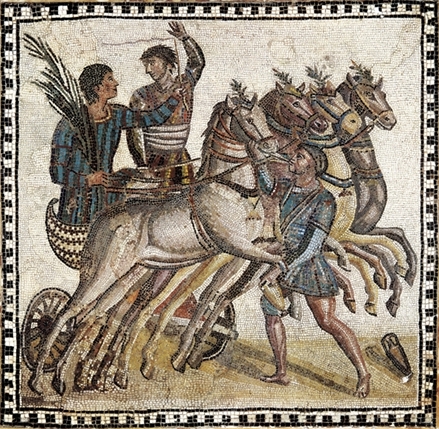
Victorious quadriga of the Blues (ancient mosaic)
The circus factions in the later Roman and early Byzantine empires played important roles in social life. Members were appointed different tasks, for example military ones, like defense of the city walls. Their most significant activity occurred from the V to VII century A.D. Further, city guards were unable to control public order without the support and cooperation of these factions. Sometimes, however, sportingemotions and political intriguedeveloped to the point that serious rioting and open street fights were a threat to the authorities.

Gold coins form the time of the emperor Octavian August (63 BC–14 AC) and Constancius II (317-361 AC) depicting the famous winners of chariot races. Winners’ portraits were often placed on coins along with those of the rulers.
There was great social unrest during the rule of the Emperor Justinian I, in January 532 A.D. At that timethe noble word “nika” gained a new meaning. These riots at the hippodrome resulted from the arrest of several Blues and Greens accused of murder during fights between both factions. Such riots were nothing new in the empire. Thesehad broken out when seven participants in the fight were recognized and sentenced to death. The executioner, however, did not properly carry out his task and two of the convicted survived, escaped from the site of the intended execution and found refuge in the nearby St. Lawrence church. The church was soon surrounded by an angry mob. The emperor found himself in a difficult situation. On the one hand he was involved in difficult peace negotiations with the ruler of Persia. On the other, domestic tension had gradually increased because of high taxes. Nonetheless, the emperor announced the date of the next race and ordered the re-arrest of the fugitives. But the Blues and the Greens demanded their instant pardon. On January 13 the furious crowd filled the tribunes of the hippodrome and the emperor lost the Blues’ support.
In Constantinople the hippodrome was adjacent to the emperor’s palace. Thus the ruler could watch the races from his palace lodge, where he felt quite safe. From the very start the spectators shouted and insulted the emperor, and then during the twenty-second race, they shouted but one word: nika!They then rushed to attack the palace, which was laidsiege for fiveconsecutive days. A fire in this part of the city led to the destruction of, among others, the Senate building and the famous basilica of Hagia Sophia.
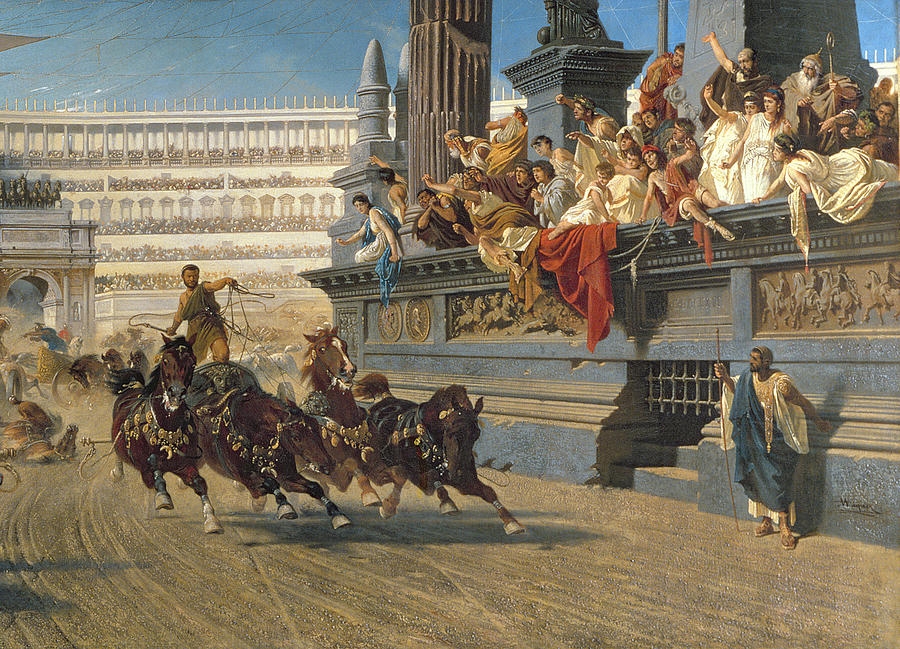
A part of the aristocracy thought the riots to be the right moment to overthrow Justinian. A new emperor, Hypatius, who was a member of the Greens, was proclaimed.However, Justinian used force to carry out a massacre of his opponents. Roughly 30 thousand rebels were killed at the hippodrome, including the pretender Hypatius. All the senators who had supported the revolt, later called the Nika uprising, were exiled. The word “nika”, which until then had been a synonym for noble struggle and sports competition, gained a new and bloody meaning. Thus ended both the races and the factions. Ten years later an epidemic of plague broke out. It lasted four months and killed over 300,000 people in the Constantinople alone. It is estimated that as a result of the disease, which turned into a pandemic, often called Justinian’s plague,100 million people died across the known world.
After the epidemic Justinian ordered the capital rebuilt and a new basilica of Hagia Sophia constructed. However, both these tragic events collided with Justinian’s ambitious plans to restore the power of the Roman Empire as a whole.
He continued his despotic rule and permanently introduced elements of Christian religion and eliminated paganism. He held unlimited religious power and called synods that decided about dogmas of faith. As a result, the Orthodox Church declared him a saint. And his slaughter of thousands of people during the Nika uprising was quickly forgotten. Instead, history remembers this controversial emperor as an art patron and giver of law, who founded the structures of civil and criminal jurisdiction.

When Nika HP was first established it adopted its name to refer to the noble idea of “nika”, the beautiful tradition of races at Roman hippodromes, the healthy rules of sports competition, and hard work and success. The company’s color refers to one of the ancient factions - Venetoi, the Blues. The logo, unchanged for over 20 years, resembles one of the pictograms in the computer phont of Jasna Polana. Jasna Polana in Princeton, USA is an estate of the late Barbara Piasecka-Johnson, who was a long time patron of all research on lysozyme dimer.



 What’s new
What’s new About the company
About the company Products
Products Online
Online Publications
Publications Trainings
Trainings
